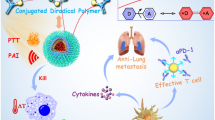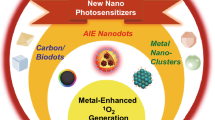Abstract
Photodynamic therapy (PDT) is an alternative to traditional cancer treatments. This approach involves the use of photosensitizer (PS) agents and their interaction with light. As a consequence, cytotoxic reactive oxygen species (ROS) are generated that, in turn will destroy tumors. On the other hand, ZnO is a biocompatible, nontoxic, and biodegradable material with the capability to generate ROS, specifically singlet oxygen (SO), which makes this material a promising candidate for 2-photon PDT. Doping ZnO with Li species is expected to induce defects in the host oxide structure that favors the formation of trap states that should affect the electronic transitions related to the generation of SO. The present work reports the effect of the level of Li-doping on the ZnO structure and its capability to generate SO. Li-doped ZnO nanoparticles were synthesized under size-controlled conditions using a modified version of the polyol method. XRD measurements confirmed the development of well-crystallized ZnO Wurtzite; the average crystallite sizes ranged between 13.3nm and 14.2 nm, with an increase in Li content. The corresponding band gap energy values, estimated from UV-vis measurements, decreased from 3.33 to 3.25 eV. Photoluminescence (PL) measurements of Li-ZnO revealed the presence of emission peaks centered on 363nm, 390nm, and 556 nm; these emission peaks correspond to the exciton emission, transition of shallow donor levels near of the conduction band to valence band such as interstitial Zn, and oxygen vacancies, respectively. The observed increase of the emission intensity of the 390 nm emission peak, relative to the intensity of the main emission peak at 363nm, was attributed to the promote of trap states due to interstitial Zn or Li-incorporation into the host oxide lattice. SO measurements evidenced the enhancing effect of the Li concentration on the capability of the doped ZnO to generate this species. This Li-dependence of SO generation can be attributed to the enhancement of the concentration of trap states in the host ZnO, as suggested by PL measurements. Accordingly, Li-ZnO would become cytotoxic to cancer cells via photo-induced ROS generation enabling this nanomaterial to be considered as a potential direct PS agent for the 2-photon PDT route.
Similar content being viewed by others
References
C. Robertson, D. Hawkins, H. Abrahamse . Photodynamic therapy (PDT): a short review on cellular mechanisms and cancer research applications for PDT. J Photochem Photobiol B. 96, 1–8 (2009).
A. Garg , D. Nowis , J. Golab , P. Agostinis. Photodynamic therapy: illuminating the road from cell death towards anti-tumor immunity. Apoptosis. 15, 1050–1071 (2010).
R. Hudson, R. Boyle. Strategies for selective delivery of photodynamic sensitisers to biological targets. J Porphyrins Phthalocyanines. 8, 954 (2004).
R. Almeida, B. Manadas, A. Carvalho, Duarte. Biochim. Biophys. Act . 1704, 59(2004).
D. Klaus. Handbook of Nanophysics. Nanomedicine and Nanorobitcs, edited by D. Klaus. (CRC Press, 2011), Chap. 22 p. 17.
M. Mansoor. Nanotechnology for Cancer Therapy.(CRC Press, 2006), p.59.
R. Braj , N. Brahma , W. Khan, H. Singh, A. Naqvi. ROS-mediated apoptotic cell death in prostate cancer LNCaP cells induced by biosurfactant stabilized CdS quantum dots. Biomaterials. 33, 5753 (2012).
L. Honglin, Z. Zhong, H. Jinzhao, L. Ruxi, W. Qingbao. Optical and structural analysis of rare earth and Li co-doped ZnO nanoparticles. Journal of Alloys and Compounds, 550, 526–530(2013).
Y. Xia, S. Huali, L. Weirong, G. Weizhong, S. Xiaoli, M. Yiqun. Endoplasmic reticulum stress and oxidative stress are involved in ZnO nanoparticle-induced hepatotoxicity. Toxicology Letters 234, 40–49(2015).
A. Hal, A. Vecchio-Sadus. Toxicity of lithium to humans and the environment-A literature review. Ecotoxicology and Environmental, 70, 349–356(2008).
T. Yu-Chih, L. Yow-Jon, C. Hsing-Cheng, C. Ya-Hui, L. Chia-Jyi, Z. Yi-Yan. Dependence of luminescent properties and crystal structure of Li-doped ZnO nanoparticles upon Li content. Journal of Luminescence 132, 1896–1899(2012).
Y. Collantes, O. Perales- Pérez. Structural and Functional Properties of Iron (II, III)-Doped ZnO Monodisperse Nanoparticles Synthesized by Polyol Method. Materials Research Society, 2013.
B. Cullity. Elements of X-Ray Diffraction, edited by Morris Cohen (Addison Wesley, MA, 1972), p. 102.
S. Awan, S. Hasanain, M. Bertino and G. Hassnain. Effects of subtitutional Li on the ferromagnetic response of Li co-doped ZnO:Co nanoparticles. J.Phys.: Condens. Matter,25, 156005(2013).
E. Jeong , H. Yu, Y. Kim, G. Yi, Y. Choi, S. Han. Local structural and optical properties of ZnO nanoparticles. Journal of Nanoscience and Nanotechnology, 10, 3562–3565(2010).
V. Ischenko, S. Polarz, D. Grote, V. Stavarache, K. Fink, and M. Driess. Zinc oxide Nanoparticles with Defects. Advanced Functional Materials, 15, 1945–1954(2005).
Author information
Authors and Affiliations
Rights and permissions
About this article
Cite this article
Martínez Julca, M.A., Rivera, I., Perales-Pérez, O. et al. Li-Doped ZnO Nanoparticles as Novel Direct Generator of Singlet Oxygen for Potential Photodynamic Therapy Applications. MRS Online Proceedings Library 1784, 15213656501 (2015). https://doi.org/10.1557/opl.2015.625
Published:
DOI: https://doi.org/10.1557/opl.2015.625




